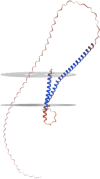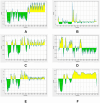Reviewing advancement in Mycoplasma pneumoniae P30 adhesin protein provides insights for future diagnosis and treatment
- PMID: 39735188
- PMCID: PMC11671514
- DOI: 10.3389/fmicb.2024.1515291
Reviewing advancement in Mycoplasma pneumoniae P30 adhesin protein provides insights for future diagnosis and treatment
Abstract
Mycoplasma pneumoniae is a major pathogen that causes upper and lower respiratory tract infections in children, adolescents, and elderly individuals and can lead to pneumonia, intrapulmonary and extrapulmonary complications, and respiratory sequelae. M. pneumoniae must adhere to respiratory epithelial cells of a host for infection. The P1 and P30 proteins, as two adhesin proteins of M. pneumoniae, have attracted extensive attention from many researchers. In this paper, we present the latest research progress on the P30 protein in terms of structure and mutation typing, physiological function, clinical serological diagnosis and vaccine development in a literature review. This study deepens our knowledge on the pathogenesis of M. pneumoniae and is useful for diagnosing and preventing M. pneumoniae infection.
Keywords: Mycoplasma pneumoniae; P30 protein; adhesion; diagnosis; vaccine.
Copyright © 2024 Zuo, Zhang and Li.
Conflict of interest statement
The authors declare that the research was conducted in the absence of any commercial or financial relationships that could be construed as a potential conflict of interest.
Figures






Similar articles
-
Strategy to create chimeric proteins derived from functional adhesin regions of Mycoplasma pneumoniae for vaccine development.Infect Immun. 2009 Nov;77(11):5007-15. doi: 10.1128/IAI.00268-09. Epub 2009 Aug 10. Infect Immun. 2009. PMID: 19667041 Free PMC article.
-
Mycoplasma pneumoniae Infections: Pathogenesis and Vaccine Development.Pathogens. 2021 Jan 25;10(2):119. doi: 10.3390/pathogens10020119. Pathogens. 2021. PMID: 33503845 Free PMC article. Review.
-
Protective immunity induced by a novel P1 adhesin C-terminal anchored mRNA vaccine against Mycoplasma pneumoniae infection in BALB/c mice.Microbiol Spectr. 2025 Mar 4;13(3):e0214024. doi: 10.1128/spectrum.02140-24. Epub 2025 Jan 20. Microbiol Spectr. 2025. PMID: 39831768 Free PMC article.
-
Development of protective anti-Mycoplasma pneumoniae antibodies after immunization of guinea pigs with the combination of a P1-P30 chimeric recombinant protein and chitosan.Microb Pathog. 2013 Nov;64:23-32. doi: 10.1016/j.micpath.2013.07.004. Epub 2013 Aug 13. Microb Pathog. 2013. PMID: 23948467
-
Exploring the pathogenetic mechanisms of Mycoplasmapneumoniae (Review).Exp Ther Med. 2024 Apr 30;28(1):271. doi: 10.3892/etm.2024.12559. eCollection 2024 Jul. Exp Ther Med. 2024. PMID: 38765654 Free PMC article. Review.
Cited by
-
Advances in adhesion-related pathogenesis in Mycoplasma pneumoniae infection.Front Microbiol. 2025 Jul 23;16:1613760. doi: 10.3389/fmicb.2025.1613760. eCollection 2025. Front Microbiol. 2025. PMID: 40771685 Free PMC article. Review.
References
-
- Baseman J. B. (1993). “The Cytadhesins of Mycoplasma pneumoniae and M. genitalium” in Mycoplasma Cell Membranes. eds. Rottem S., Kahane I. (Boston, MA: Springer, US; ), 243–259. - PubMed
Publication types
LinkOut - more resources
Full Text Sources

